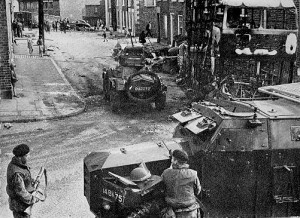Today in Irish History, 9 August 1971, Internment is introduced in Northern Ireland
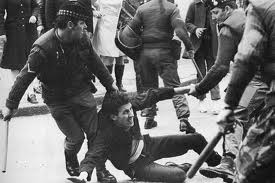 John Dorney on a turning point in the history of the Northern Ireland conflict.
John Dorney on a turning point in the history of the Northern Ireland conflict.
The morning of Monday the 9th of August, 1971 was misty in Ballymurphy, a public housing estate of white semi-detached houses, the model of 1960s modernity, in west Belfast, under Divis Mountain.
This morning though, the dawn gloom was broken by the piercing headlights of British Army armoured cars, which disgorged squads of beret-wearing paratroopers. Doors were kicked in and men, often addled by sleep, dragged away. Before long, the predominantly nationalist area had woken up amid howls of rage from the families of those who had been taken.
The air was filled with a deafening din of dustbin lids being banged off the ground by the women – a warning to wanted men to get way. Teenagers pelted the troops with stones and petrol bombs and before long the sounds of shouts, curses and the dull bang of rubber bullets was replaced with the harsher crack of high velocity gunfire, exchanged between the Army and republican paramilitaries.[1]
In Derry, leftist activist Eamonn McCann wrote,
‘As the noise of the internment operation wakened the area at about 4 in the morning, people poured onto the streets. The resistance prevented the army completing its swoop…By dawn the area was hysterical with hatred. In Brandywell, Bogside and Creggan there were street corner meetings in progress. Local people told of their experiences: how the soldiers had dragged Peter Collins down the stairs by the hair of his head; how they didn’t even give Micky Montgomery time to dress just kicked him into the land rover in his underclothes; how they had come for John Carlin of Anne Street and not finding him there, had instead taken his father who was over sixty and fired a rubber bullet into his stomach from point blank range and then threw him into a truck.”[2]
This was the morning in which internment without trial had been introduced, under the 1922 Special Powers Act, into Northern Ireland by its Prime Minister, Brian Faulkner. There had been a list of 450 people to be arrested, but a total of 342 were picked up. All but two were Catholics and nationalists and the remaining two (most notably Ronnie Bunting) were Republican activists. No loyalists were arrested.
Faulkner told the media, “every means has been tried to make terrorists amenable to the law. But the terrorist campaign continues at an unacceptable level. And I have had to conclude that the ordinary law cannot deal quickly or comprehensively enough with such viciousness.”
Internment was a PR disaster, not only for the Northern Ireland government – already all but at war with parts of its Catholic population, but more importantly for the British Government and its Army in Northern Ireland – who had carried out what was seen as a one-sided and arbitrary operation against the northern Catholic community at the behest of the Unionists.
On August 9-10 1971, the British Army arrested over 300 people without trial. Over the next four days 24 people were killed and up to 7,000 intimidated from their homes
Over the next four days, 24 people were killed in rioting and gun battles across Northern Ireland. Some 7,000 people, both Catholics and Protestants, were expelled from their homes.
One group it did not damage badly though was the nascent Provisional IRA. Its commander in Belfast, Joe Cahill – a nondescript-looking middle aged man with huge black glasses and flat cap – felt confident enough to hold a press conference in west Belfast, on August 13th, where he told the press, “Up to the present we have lost one Brigade officer, one Battalion officer and the rest are Volunteers, or as they say in the British Army, privates…The losses in the IRA have been very slight, we have lost 30 men arrested, two killed and eight wounded. We had prior warning of this round up and consequently took the necessary precautions”.[3]
To the swelling ranks of Provisional Republicans, internment simplified matters greatly. The British government was on the same side as the, ‘Orange state’ of Northern Ireland. It had to be fought in order to win a United Ireland.
To many other parties to the Northern conflict though, internment was a disastrous event that deepened of the spiral into multi-sided violence which no party could really win. How did this happen?
A complex insurgency
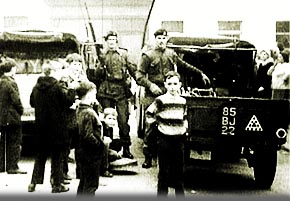
The conflict in Northern Ireland, that had broken out in 1969, would be described by military analysts today as a, “complex insurgency” – that is one without two clearly defined sides but with many different factions, all sometimes antagonistic to each other.
Violence had initially broken out in 1968-69 over the Northern Ireland state’s reaction to the agitation of the Northern Ireland Civil Rights Association for equal rights for Catholics – particularly with regard to policing, housing, electoral boundaries and employment. Marches were banned and rioting broke between the Civil Rights activists and the RUC police force. To this was quickly added another dimension as Protestant or loyalist vigilante groups (including the Ulster Volunteer Force or UVF re-founded in 1966) fought sometimes with the police, sometimes alongside them, attacking Catholic areas, particularly in parts of Belfast.
The Northern Ireland conflict was a many sided affair. The disaster of internment was that it appeared to line up the British government and its army with the most hardline unionists
The British Army was deployed in 1969 to, “restore order”, and was at first warmly welcomed in Catholic neighbourhoods as an impartial force who could be relied on, unlike the RUC or auxiliary B-Specials, to defend them from loyalists. At this point, it seemed feasible, as the more moderate elements of the Civil Rights movement (who coalesced in 1970 as the Social Democratic and Labour Party or SDLP) envisaged, that the British government in London could be an arbitrator for reform of Northern Ireland, including equal treatment for Catholics and some form of power-sharing between nationalists and unionists.
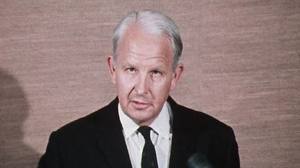
And there were reforms in 1969-70. A commission was set up to redraw electoral boundaries to make them representative of Catholic numbers. A Housing Executive was formed to fairly allocate public housing. The B-Specials – a reserve police force but effectively a unionist militia, was disbanded in late 1969 and an inquiry was set up to reform the police.
The problem with the idea of the British government as a kind of impartial referee was that Northern Ireland, since 1922, had had its own government, elected to a Parliament at Stormont, outside Belfast and its own police forces. Protestants and unionists were a majority of about 65% in Northern Ireland and viewed any concessions to nationalists as at best, a sop to, ‘treachery’, and at worst the first step towards the end of Northern Ireland itself and its incorporation into a United Ireland. Events such as the disbanding of the B-Specials had seen severe rioting between British troops and loyalists, including shots fired at the soldiers.
The British government therefore had to balance reform of Northern Ireland with the powers of the autonomous unionist administration there and with unionist public opinion which wanted to see, ‘terrorism’, being put down.
And, ‘terrorism’, or armed opposition to the state from Republicans, there already was. The IRA’s position in 1969, strongly influenced by a Marxist-leaning leadership, had been to back the Civil Rights movement, build support across the sectarian divide and only then contemplate revolutionary violence against Northern Ireland. Events had caught up with them though, as IRA members were compelled to try to defend Catholic area from attack. This had resulted in a split in the organization with the more militant breaking off to form what became known as the, ‘Provisional’ IRA (though they never used the term) dedicated to the traditional objective of pursuit of a United Ireland by means of an armed campaign.
In the first half of 1971, the ‘Provos’ had begun their war, killing their first British soldier in February (one of six killings up to August 1971), and exploding 220 bombs across Northern Ireland. The other IRA faction, known as the ‘Official’ IRA, stated that their policy was one of defense only, but had also exchanged fire with the British Army and with loyalists and from time to time with the Provisionals as well.
The confluence of unionist pressure and the threat from Republican paramilitaries meant that increasingly, the British Army was being used, not only to restore public order but to combat the IRA. In practice this meant harsh measures towards the nationalist population in general. In July 1970 the Lower Falls area of Belfast was put under curfew by several thousand troops, who arrested over 300 people and killed four civilians in gun battles, mostly with the Official IRA. In Derry, the shooting by the Army of two Catholic youths in July 1971 caused the SDLP to withdraw from the Stormont Parliament an break off negotiations with both unionists and the British government.
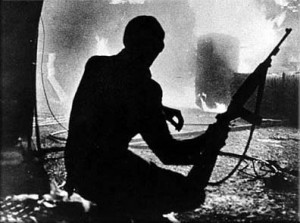
For Brian Faulkner, the new (March 1971) and hardline Prime Minister of Northern Ireland though, the problem was that the Army was not being harsh enough; “The kernel of our immediate problem in Ulster is the law and order situation. We don’t need new principles, what we need are practical results on the ground…in the elimination of terrorism, in the elimination of sabotage and in the ending or riots and disorder”. To try to assuage unionist anger over reform, the British government, headed by Prime Minister Edward Heath, swung too far in the Faulkner’s direction.
A March 6th meeting illustrated the bind Heath was in. Harry Tuzo, the British Army commander in Northern Ireland said he was prepared to “act ruthlessly”, but was worried about the effect on, “decent Catholics”. The Prime Minister told him he didn’t want, “troops tramping through house and ripping up floorboards” but he did need, “to show the Protestants that Army is acting”, in order to, “prevent a Protestant revolt”. [4]
It was Faulkner’s rather than Heath’s government that introduced internment but Heath had to give his consent for use of the British Army. In a July 1971 a Home Office Meeting was told that the RUC had compiled 375 names of men to be arrested and that facilities were being made ready aboard the HMS Maidstone ship and in the disused Air Force base at Long Kesh to hold prisoners. Heath approved of the idea, hoping it would provoke a decisive confrontation with the IRA in which they would be routed, but the Army had advised against it in the absence of good intelligence. [5]
It was at a meeting between Faulkner and Heath in August 5th , 1971 that the British Prime Minister assented to Faulkner’s plan to introduce internment without trial of Republican suspects. The British cabinet stressed that, to be even handed, such a measure would also have to include, “balancing action”, such as the arrest of loyalist militants, the calling in of weapons held by (generally unionist) rifle clubs across Northern Ireland and the indefinite ban on parades, particularly those by the Orange Order, which, by marching through Catholic areas of Dungiven, had provoked serious rioting that summer.
Remarkably, Faulkner got his way on almost every point. A ban on parades, he argued was unworkable, the gun clubs posed no security risk and there was no evidence of loyalist terrorism. Moreover, when asked, he said that he anticipated no new reforms within Northern Ireland. It was eventually agreed that there would be a six-month ban on parades but no targeting of loyalists and that internment would go ahead on August 9th, in an operation carried out by the Army.[6]
Internment, it was argued, had succeeded in defeating republican campaigns in the North in 1922 and again in 1956-61. But the context in 1969 was very different from previous eras. Now a significant proportion of the Catholic population was mobilized and radicalized in both violent and non-violent resistance to the state. RUC intelligence was poor and many of those arrested had no connection to Republican paramilitaries – who conversely, seem to have been well aware that a ‘round up’ was coming. Thirdly the behaviour of troops carrying out the operation, often like the Paratroopers in Ballymurphy, combat units, was in many cases brutal.
And another difference from the 1950s was that internment was instituted on one side of the border only. Republicans, ‘on the run’, from the Northern authorities, could simply slip across into the South. The Republic’s government under Jack Lynch, conscious of the threat republicans posed to their own state, had had plans for internment, but such was the anger among their population at the treatment of Northern nationalists in August 1971 that such plans had to be shelved.[7]
There was a security problem for the British Government in Northern Ireland but the way internment, what the British Army called Operation Demetrius, was carried out was perhaps the worst possible way of dealing with it.
Violence
In Derry in the days after internment, Eamonn McCann recalled, “there were so many people wishing to play an active role in resisting the Army that it was almost impossible for the IRA to use guns.”
Rioting and gun battles continued for four days after internment was introduced
In Belfast the violence was even more serious. In Ballymurphy the Parachute regiment shot dead eleven local men, including a priest, over August 9-10. Their sandbagged base on the Springfield road was repeatedly raked with gunfire from local Provisionals. Young journalist Malachi O’Doherty fortunately decided against joining in the rioting. Two young men were shot dead at the end of his street by troops in a passing armoured car.[8]
In the Lower Falls, the Offical IRA’s heartland, both IRA factions fought running battles with the British military, allowing most of their members to get away. Joe McCann, an Official IRA leader set ablaze the Inglis Bakery and with 6 men, according to republican folklore, held off 600 British troops before making his escape over the rooftops. A lucky photographer snapped McCann under the Starry Plough flag, holding an M1 carbine silhouetted against burning barricade – a potent image for republican propaganda.
Further up the Falls, gun battles broke out between Republicans and loyalist snipers in Protestant Shankill.[9]
In Ardoyne in north Belfast, local Catholics turned their anger not only the troops but also on the Protestants in the area. Several hundred families left the mostly Catholic neighbourhood, many burning their houses behind them to prevent Catholics, who in turn were intimidated out of adjacent localities, occupying them. News footage show the departing Protestant youths defiant, on trucks piled with furniture, leaving the area, draped in Union jacks and giving the V sign at their persecutors.[10]
Kevin Myers, at that time RTE’s Northern correspondent, recalled witnessing a gun battle between Catholics and Protestant in Ardoyne. Around one corner three Catholic teenagers were felled by a loyalist sniper, around another, a Protestant lay dying from a bullet wound. “ ‘Them Fenian bastards, they’ll pay for this’, a bystander snarled. ‘They already are’, I replied, ‘I just put a dead Catholic boy in a car’. ‘You mean we got one? Do you hear that lads, we got a wee Fenian around the corner’…’Aye and he’ll not be the fucking last’.[11]
Aftermath
Internment almost plunged Northern Ireland into a revolutionary situation but northern nationalists were too small a minority to overthrow the state by themselves
The manner in which people were arrested was enough to madden the nationalist population, but even worse was the reports that filtered back of the treatment internees had received at the hands of their interrogators.
McCann recalled, “Apart from the run of the mill beatings up, which everyone assumed would happen, the [RUC] Special Branch had kept men hooded and spread eagled against walls for hours on end given them no food but bread and water and played ‘white noise’ into their ears”.[12]
One of the internees of 1971, a Provisional IRA member recalled in 1993, “We were stripped naked. They said, ‘do you want a Guinness?’ Outside you were introduced to this dog called Guinness – a big brute. In them days it was complete physical violence, hot and cold baths, pulling your testicles, pulling your hair. They just fucked [threw] you into hot water and held you down. It’s terrible when you’ve got nothing to tell them”.[13]
“The thought of this happening to people from our streets”, McCann wrote in 1974, “contributed greatly to the rising fury.”
The European court of Human Rights, at the behest of the Irish Government, censored the British government for use of torture.
In the short term, Northern Ireland was plunged into a near-revolutionary situation – nationalists withdrew from participation in local government. The SDLP led by John Hume set up an alternative Assembly in protest at the Stormont Parliament, the Civil Rights Association called a rent and rates strike which was largely observed in nationalist areas. Some 8,000 workers staged a one day strike in Derry against internment.
Had the demographic realities of Northern Ireland been different this might really have spelled the end for the Northern state. But the fact remained that unionists were a majority of nearly 3-1 in the six counties. Northern nationalists could not win by themselves. So the result of internment was not victory for one side or the other but simply more violence.
In September 1971, the various loyalist vigilante groups, predominantly in Belfast, came together to form the Ulster Defence Association, with a clandestine wing, the Ulster Freedom Fighters. Hardline Unionist leader Ian Paisley called for the creation of another loyalist “Third Force”. The following year, the various loyalist groups would begin to kill Catholics in large numbers – in the process making a mockery of Brian Faulkner’s assurances to Edward Heath that loyalist terrorism did not exist.
Internment was phased out in 1975. During that time, just under 2,000 people were imprisoned without trial in Northern Ireland, of whom 1,875 and Republicans and 107 loyalists.[14]
The alternative posited to internment was to try paramilitary suspects in non-jury courts and then to treat them as ordinary criminals – which in turn sparked off another round of the conflict, culminating in the IRA hunger strikes for political status in 1981. In the end, the final result of the Northern Ireland conflict could only be compromise but it took all the various warring parties nearly 30 more years of bloodshed to reach one.
References
[1] See television footage http://www.youtube.com/watch?v=ur_KLdc3lG0
[2] Eamonn McCann, War and Irish Town, Pluto 1993, p148
[3] News footage, http://www.youtube.com/watch?v=egHEJkMNA0g
[4]Public Records Office of Northern Ireland (PRONI), notes of PM meeting, March 6th, 1971 see CAIn chronology for access to documents http://cain.ulst.ac.uk/othelem/chron/ch71.htm
[5] Public Records Office of Northern Ireland (PRONI), notes of HO Meeting 15 July 1971
[6] PRONI, note from Meeting PM NI and MP UK, including RUC Chief Constable and GOC, CoS Army, 5 August 1971
[8] Malachi O’Doherty, The Telling Year, Belfast 1972, p7-8
[9] Brian Hanely, Scott Millar, The Lost revolution, p166
[10] CAIN, News footage
[11] Kevin Myers, Watching the Door, p33
[12] McCann, War and an Irish Town p153
[13] Brendan O’Brien, The Long War, The IRA and Sinn Fein (1995), p53
[14] Conflict Archive on the Internet. Internment Summary http://cain.ulst.ac.uk/events/intern/sum.htm
